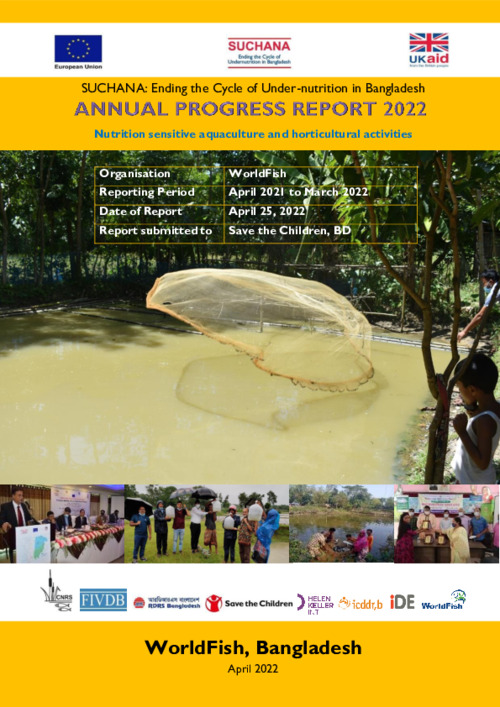Save the Children_SUCHANA: Ending the Cycle of Under-nutrition in Bangladesh_Annual progress report 2022 on Nutrition Sensitive Aquaculture, Fisheries and Horticulture activities of Suchana, WorldFish_April 2021 - March 2022
Abstract
Since beginning of Suchana program, WorldFish has been promoting nutrition sensitive fish and vegetable production systems to the beneficiary households of Suchana program. It comprises nutrition sensitive aquaculture and fisheries interventions along with the vegetable gardening to enhance dietary diversity of reproductive age women and children of less than 2 years old in Sylhet and Moulvibazar districts. Considering the expectations from the beneficiary households, WorldFish has also added to promote integrated support model through incorporating the small-scale poultry along with the aquaculture, fisheries and horticulture since 2018. 
Entire (28) targeted activities of annual implementation plan have been achieved successfully; and the progresses were in-between 99% to 214%. So, it was a great achievement for WorldFish as well as for overall Suchana program. Besides the regular technical follow-ups at beneficiary households, WorldFish conduced targeted number of trainings, workshops and linkages events, and distributed targeted inputs in collaboration with implementing partners, technical partners and the Department of Fisheries.
One of the key focuses of the reporting year was to involve the Department of Fisheries (DoF), and that have been achieved very successfully through involving the front-line officials to the Honorable Director General (DG). Local DoF officials participated most of the formal events like trainings, linkages events and fingerling distributions. They participated at least 129 joint visits, 81 quarterly and half-yearly coordination meetings and 2 annual lesion learning workshops. Finally, Honourable Director General (DG), Department of Fisheries (DoF) visited Suchana working areas in January 2022. He was the Chief Guest of “Consultation workshop with the Department of Fisheries, Bangladesh in view of contribution on revision of the National Fisheries Policy 1998” at Sylhet. More than 50 participants were attended in the event. High officials of the Department of Fisheries (DoF) Head Quarter and divisional office, entire District and Upazila Fisheries Officers, DoF of Sylhet division, journalists of different print and electronic medias, representative of Feed Companies, Fish nursery & fry hawkers and Suchana Fish farmers participated in the workshop. Senior management team, technical leads and technical team members of different components and partners of Suchana also participated in the event.
Besides the output indictors, outcome indicators have also encouraging progress. As per the key findings from the third (Oct 2019), forth (Oct 2020) and fifth (Oct 2021) semi-annual surveys, average annual fish harvest per household was increased in more than doubled within two years of interventions compare to the pre-intervention harvest at both the HFP-Aquaculture (64kg from 27kg) and IGA-Aquaculture (85kg from 31kg) of phase 3 intervention households. That was increased in triple times at IGA-Aquaculture households (75kg from 26kg) of phase 4 areas after one year of intervention, and for HFP-Aquaculture households (53kg from 30kg) of phase 4, and that was almost doubled. Consumptions per households were also increased considerably except IGA-Aquaculture households of phase 3 working areas. They also sold fish from their harvest and gifted to the neighboring households and relatives; and naturally, that was higher at IGA-Aquaculture households compare to HFP-Aquaculture households.
Based on the findings from the rapid assessment of the jointly established demo-ponds in collaboration with DoF, the average fish was harvested 132.7 kilogram per Demo-Pond BHHs in last 1ast 1 year. Largest portion (47%) of harvested fish was used to consume by the household members, 9.5 kg per Demo-Pond BHH (7%) was distributed to the relatives and neighbours, and the remaining 60.9 kg (46%) per Demo-pond BHH was sold to the market and nearby households. The average cash income was 10,153 BDT per Demo-Pond BHH by selling the additional harvested fish and the market value of the overall harvested fish per BHHs was 20,529 BDT whereas an average investment was 8,970 BDT per Demo-pond BHH. Accordingly, the average margin from the market value of harvested fish was 11,559 BDT. It is notable that many households were waiting for the main harvest for selling their fish during Ramadan considering to get a better price as that was the in between the main harvesting season. The respondents estimated that on an average 110.1 kg of fish were available within ponds as current stock (biomass); and estimated market value was 17,463 BDT per demo-pond. However, increased homestead productions have strong reflections on households enhanced household dietary diversity scores (HDDS) and minimums dietary diversity of women (MDD-W). 
Based on the success of Suchana aquaculture and fisheries activities, three introductory meetings of replication activities have been conducted with divisional officials at Sylhet and district level officials of Sunamganj and Habiganj. ‘Nutrition sensitive Carp-tilapia-mola polyculture’ for flood free areas and ‘Combination of Climate resilient aquaculture and fisheries management’ especially for flooded ponds have been selected as two best practices to replicate. Accordingly, two separate operational plans have been developed jointly and field operations have been started

